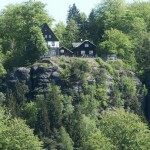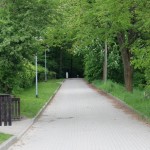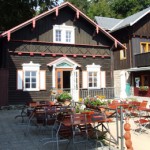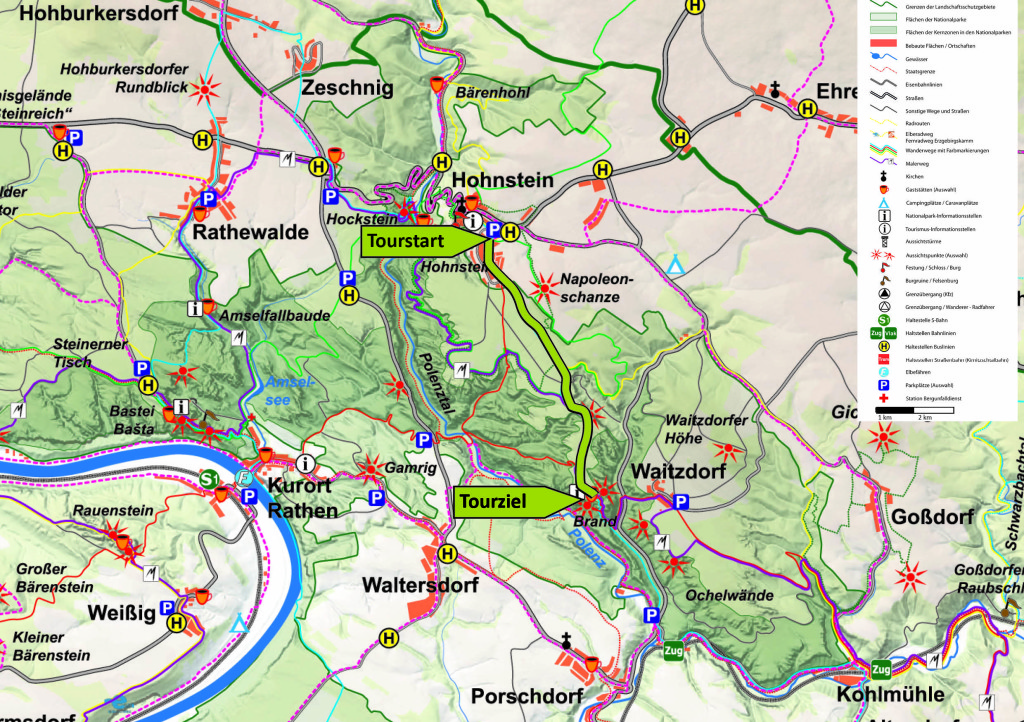Hohnstein – Brandstraße – Brand look-out and back
A hike to enjoy – there is little up and and down in the forest. The wonderful view from the Brand look-out is worth this little hike.

View from the Brand into the front and rear parts of Saxon Switzerland / Photo: Archive National Park Management, K. Jäpelt
| Distance: 5.6 km Narrowest point: no restrictions Obstacles: a total of three cross-drains along the way Accessibility in wet conditions: yes Transport connections: Bus lines 236, 237 or National Park Express U28 to Hohnstein, by car to Hohnstein car park Parking: the “Max-Jacob-Straße” car park is located directly at Brandstraße, in the urban area of Hohnstein there is more parking (mostly subject to charge) Refreshments: Brandbaude at the Brand view, various restaurants in the city of Hohnstein |
 Your tour begins in Hohnstein at the “Max-Jacob-Straße” car park (P4, subject to charge) next to the old station. Follow the signs toward “Brandaussicht” (yellow line track) on the slightly ascending road through the village for about 400 m. After a short, asphalted stretch as well as a few metres of concrete pavement, the path changes as you enter the forest (past the electric bollard) into a solid forest road. The Brandstraße is well paved and solid as it is used for forestry and catering purposes. There are only minor differences in height and only one cross-drain along the way, which should be easy to pass with a little bit of assistance.
Your tour begins in Hohnstein at the “Max-Jacob-Straße” car park (P4, subject to charge) next to the old station. Follow the signs toward “Brandaussicht” (yellow line track) on the slightly ascending road through the village for about 400 m. After a short, asphalted stretch as well as a few metres of concrete pavement, the path changes as you enter the forest (past the electric bollard) into a solid forest road. The Brandstraße is well paved and solid as it is used for forestry and catering purposes. There are only minor differences in height and only one cross-drain along the way, which should be easy to pass with a little bit of assistance.
However, the last stretch of the way to your destination is quite steep, containing two cross-drains. Once you arrive at the “balcony of Saxon Switzerland” you will find a wonderful view of Polenz Valley as well as entire Saxon Switzerland. The accessible Brand National Park Information Site offers you an overview of Saxon Switzerland and its different habitats. Children will also find it worthwhile and the Brandbaude restaraunt will be welcoming you to take a rest and enjoy some refreshments.
During your tour you will pass several places of interest (such as the Napoleonschanze and Hafersack look-out) which can, unfortunately, only be accessed through rough terrain.
 Living “high-rise”: Perfect view from the Brand look-out.
Living “high-rise”: Perfect view from the Brand look-out.
A special feature of the Elbe Sandstone Mountains is that you can find completely different natural habitats layered horizontally in very confined spaces. Thus, at the top the sun-worshippers have settled down and those who enjoy cool and moist places are well established further down below.
The Polenz Valley is a perfect example because this impressive gorge is surrounded by high rock faces and cliffs. You do not have to be a specialist to see that the vegetation at the bottom of the valley is quite different from that at the top of the rocky trenches. Below, the Polenz River runs through the valley keeping the meadows moist. Fragments of stream-alder-ash forest can be found here and typical tall forbs stretch along the river. In stark contrast, the so-called rock-reef pine forests have conquered the dry and warm conditions on the surrounding cliffs. And between these two “habitat poles” there is still a whole range of different forest types on the valley slopes on the other side of the Polenz River.
The climatic conditions are a major cause for such different habitats. Valley bottoms and the lower reaches of the gorges and ravines capture only very little sunlight. The lack of wind, the coolness and the dampness create a true so-called “cellar climate” – in total contrast to that at the top of the rocks. No wonder then, that in the cool and humid canyons of the Elbe Sandstone Mountains you can discover plants that are otherwise only found at higher altitudes in the European mountains.
Some metres above our valleys life must adapt to very different conditions. The soils on the rocks are flat and dry and they can reach extremely high temperatures in the summer and very low temperatures in winter. On some summer days temperatures can go up to a good 60°C. In the winter -20°C are not uncommon. Only speciallist plant species can adapt to life in such extreme locations.
















Comments are closed, but trackbacks and pingbacks are open.